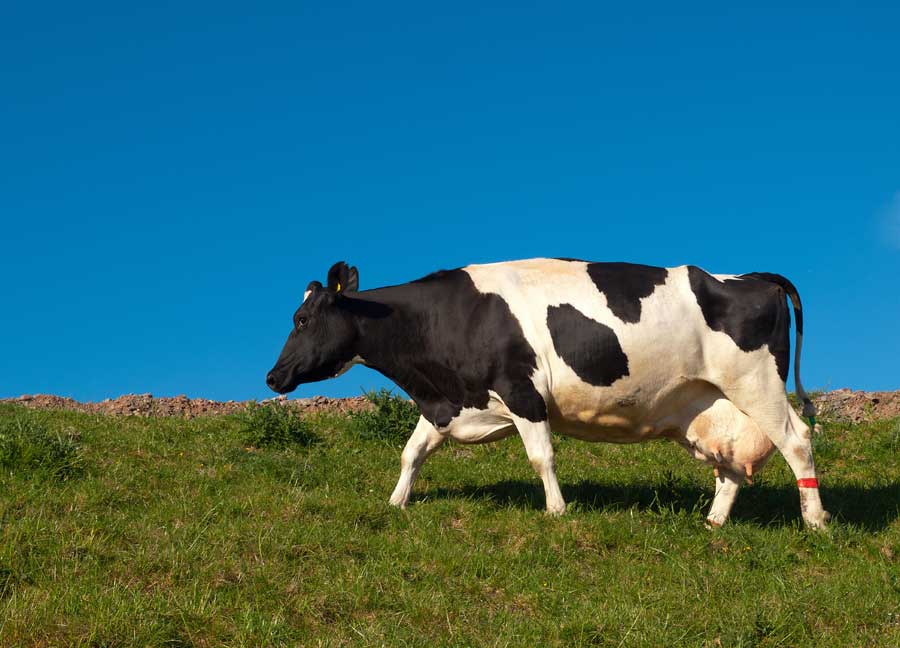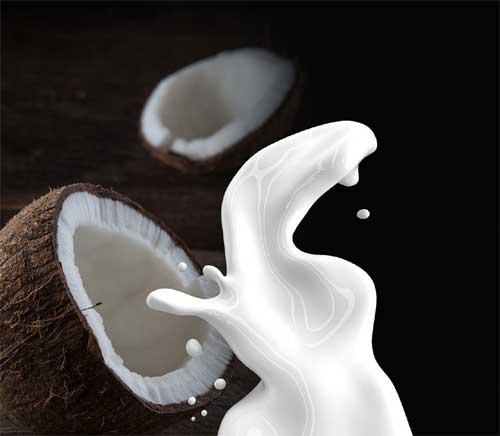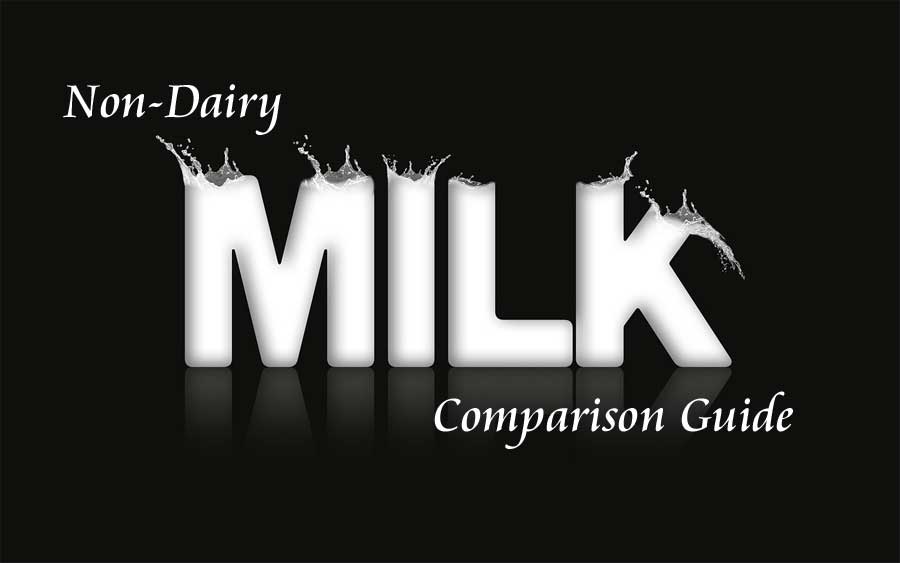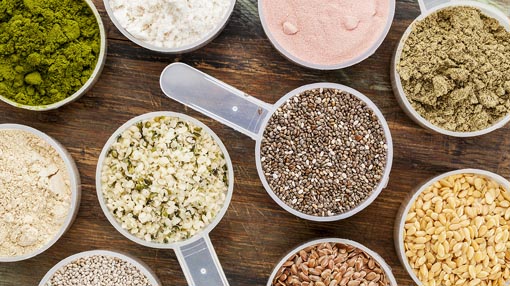Battle of the Milks - Dairy and Non-Dairy

This topic was proposed as an Ask the Yogi question from one of my students who wanted to know the virtues and differences between all those non-dairy milks out there. I thought it was an excellent topic since off the top of my head at that moment all I could think of was soy milk and almond milk, but I felt sure there must be others. Boy was I right. As it turns out you can make 'milk' out of practically anything although what you find on store shelves is a somewhat lesser assortment.
Milk, whether dairy or other, is typically a liquid that is either consumed as a drink or used as a wetting agent and partner for something like cereal. It is often used as an addition to other drinks, like coffee or tea and it also is used as an ingredient to smoothies, milkshakes and creams and sauces.
A comparison of this humble and ubiquitous substance of dairy milk to other non-dairy replacements is going to be a long one, so I will address it in several parts allowing you to read the sections that appeal to you the most.
All About Dairy Milk - The Good and Bad of this Beverage
Comparison List - How to rate each choice
Milk Made from Beans
Make Your Own Non-Dairy Milk
Milk Made from Nuts
Milk Made from Grains or Seeds
Non-Dairy Milk Blends
Summary Chart - Who Wins the Milk Battle

Dairy milk
Before delving into all the alternatives, let's just focus a moment on why we would want an alternative to dairy milk. It is after all, easy to acquire and relatively inexpensive. And to be clear, when using the term milk, most people will think of the ubiquitous cow's milk. Every grocery store, convenience store and even 'dollar' stores carry milk in its variety of 1%, 2% and whole milk.
These days the percentages of milk fat are far from the only differences in dairy milk. Our choices range from organic, grass fed, lactose free, omega-3, jernsey cow, goat's milk, sheep milk and, owing to the fact I just read an article about it, pig's milk, although in this case it is used exclusively in creating cheese and if you want to read more about it you can look here: http://modernfarmer.com/2014/03/milk-pig
The nutritional facts about cow's milk are that it has about 8 grams of protein per cup and 12 grams of sugar and then as far as fat you can choose from skim milk with zero grams of fat, 1% with 2.4 grams, 2% with 4.9 grams and whole milk with 8 grams of fat per cup.
Goat's milk has 9 grams of protein per cup and 11 grams of sugar and 10 grams of fat. I have never found options for lower fat goat's milk.
Sheep's milk surprised me with its nutritional profile. Per cup, sheep's milk has 15 grams of protein 13 grams of sugar and 17 grams of fat. Although I have seen sheep's milk yogurt on the shelves, I have yet to see actual sheep's milk at my local Whole Foods. All I could find as far as a resource for sheep milk is through this site:http://www.agrilicious.org/local/sheep-milk
So, for a single cup we can get a good amount of protein, a moderate amount of sugar and choose from zero to moderate amounts of fat. It actually is a very good drink when we consider these facts. Yet, some people find drinking milk causes them problems.
Lactose Intolerance
What bother's people the most about dairy milk is not the protein of the milk in most cases, but rather the milk sugar, or lactose. Very few people have a true milk allergy, meaning they are allergic to milk protein. Most people who have trouble with dairy are lactose sensitive or lactose intolerant.
We start off life being quite capable of consuming milk in the form of human breast milk. Breast milk nutritional composition is 2.5 grams of protein, 17 grams of sugar and 11 grams of fat per cup. As the primary food source for our first 6 months of life and then as a continued additional food source for possibly two more years, humans are well adapted to digest milk and the milk sugar, lactose. We can digest lactose because our body produces the enzyme lactase which breaks down the lactose allowing us to absorb this carbohydrate. Following weaning we typically will retain our ability to digest lactose especially if we are exposed to other forms of dairy.
In some cultures where dairy farming was traditionally absent, lactose intolerance in adults is common. Those of us who come from these non-dairy farming ancestry may be more likely to have trouble with milk sugars as adults.
Most adults, however will be able to digest about the amount of milk sugar found in a cup of milk, about 12 grams of lactose. If they consume more then they might feel some complaints of gas pain and bloating since there is not enough lactose to process the milk sugar. The unprocessed milk sugar begins to ferment in the digestive tract creating intestinal gas and the accompanying discomfort. This group of people would be termed lactose sensitive since they can consume small amounts of milk.
Lactose intolerance is a term for those who begin to have symptoms with the ingestion of small amounts of milk. This group of people produce little if any lactose as adults. Sometimes this is due to genetics but other times this comes as a result of illness or surgery. Sometimes the condition is temporary and other times it is life long.

Other Reasons for Avoiding Dairy
Milk protein allergy and lactose intolerance are the two main reasons to avoid dairy, but some people avoid it for other reasons. Some people are concerned that dairy milk contains unwanted elements. Although factory farming with its use of pesticides on animal feed, antibiotics in animals and additional hormones given to the animals does create a less than optimal milk product this is no longer our only option for dairy milk. Whenever possible it is best to chose organic milk options.
Some people point to how the animals are fed grains instead of their natural fodder of grass causing the milk to have a less optimal nutritional profile. It is true that cows that are grass fed produce a more nutritionally optimal milk and luckily grass fed milk is now an easily found item.
Some people are concerned that the standards of pasteurization 'ruin' the milk by altering the nutritional components. Pasteurization heats the milk in order to kill unwanted pathogens. High heat, short term pasteurization will extend the refrigerated shelf life of milk to two or three weeks. This type of pasteurization heats the milk to 161 degrees for 15 seconds. Ultra-pasteurized milk has a shelf life of two to three months. This type of pasteurization sprays the milk through a nozzle into a 140 degree steam filled chamber for four seconds and then cools it instantly in a vacuum chamber where it is packaged into airtight containers. Since improperly handled raw milk is responsible for three times more hospitalization than other food borne disease outbreaks, it is safe to say that what is being altered in the pasteurized milk is the potential of the milk harming us. Unless we can verify the cow is bacteria free, the method of milk collection is sterile and the milk goes from cow to us in an extremely short period of time, raw milk products are risky.
Some people just think that milk by its nature is unhealthy. I have looked through scores of nutritional data and studies and have yet to find any evidence of a specific unhealthy component to dairy milk that cannot be modified by selecting organic, grass fed options and using portion control. Yet I can also tell you that I have not found any compelling scientific data that says we need to drink dairy milk. It is an option that some people choose and some people for various reasons choose to avoid.
So, if we are going to avoid milk and replace it with another substance, the replacement should be at least as nutritious as dairy milk. Thus dairy milk will become our standard we use for comparison.

Non-Dairy Milk Comparison
For the best comparison there needs to be a reasonable factor regarding nutritional requirements. Using cow's milk nutrition as the standard will allow a basis of comparison that will look for levels of protein, carbohydrate and fat. Other nutritional factors to consider will be minerals and vitamins present in the beverages. Color will be factored in as well since I feel most people might not favor at a strange color. Texture and viscosity will be mentioned as most will want the beverage to be a smooth texture with milk like thickness. Taste will be mentioned but I don't consider this as much of a factor since what we like as far as taste varies widely from person to person. Taste can also be altered easily with additional ingredients like vanilla.
Our Comparison List
For an 8 ounce serving, here are the standards that will be used for our comparison of the non-dairy milks:
- Protein - 8 grams
Since milk is touted for its protein, we will compare the protein of other drinks to see how they rate to this ideal. - Carbohydrate - 12 grams which is 50% galactose and 50% lactose sugar
Milk sugar is composed of lactose and galactose. This sugar provides a source of energy, so we will what sugar the other beverages offer. - Fat - 0 - 8 grams depending on skim, 1%, 2% or whole milk
Since the fat varies depending on the type of milk, we will be looking for fat amounts in these ranges. - Vitamins and Minerals - Calcium 276 mg and D 98 IU
Milk is touted as a good source of calcium so we will see how other beverages stack up for this mineral. Milk is fortified with vitamin D so we will see if other beverages offer this important nutrient. - Color - White
This is not the only color we can accept, but it would be good to know what color is going to come out of the carton so we are not surprised. - Texture - Smooth
Since milk has a smooth texture we will note if the other beverage is similar. - Thickness - 2 - 4 depending on type
We will use the following thickness scale which as you can see varies even for milk.
1= water, 2= skim milk, 3= 2% milk, 4= whole milk, 5= milk shake,
Part 2 - Types of Non-Dairy Milk

Would you like to have a yoga mat that meets your individual needs? The modern world of yoga mats is filled with a multitude of choices. This review will quickly and easily guide you through the important differences...
Do your wrists bother you in some yoga poses? You are not alone. Learn how to avoid this common complaint and how to increase your wrist strength and comfort...
Increasing the protein in your diet can allow you to achieve greater strength gains and enhance your recovery from exercise. Protein powders are a great way to bring in extra protein without a lot of extra calories. Learn the differences between the many types...
Hoodies and yoga go great together...
This little gadget does wonders for the hand...
| Sign up for Jbyrd Yoga News and Events |

Upcoming Seminars
with Julie
Saturday's 1 - 2pm
Free - Deep Breathing Workshop
Register for Zoom Workshop
Live-stream Classes Online
Core Conditioning
Wednesdays 12:30pm
Intermediate Yoga
Thursdays 1pm
Workout With Julie
Friday 11am
All Level Yoga
Saturday 10am
My Instagram

Just got the peppers in their pots.
Latest Articles
- Growing a Container Herb Garden
There is nothing better than fresh herbs from your garden. They are useful for cooking, they smell heavenly and they look so beautiful... Mar 25, 2019
- Getting the Most Out of Fermented Foods
Sometime in the last 150 years we went from a culture that had a rich history of fermenting foods and became a culture that is obsessed with clean, sterile environments... Feb 10, 2019
Great ideas for yoga gifts...
Heart Rate Monitor Review...
Read this review of ergonomic sitting solutions...
Society 6
Jbyrd Yoga Collection
Yoga inspired artwork on tshirts, leggings, tote bags and more...
Organic gardening adventures...
Tales inspired by little furry tails...















